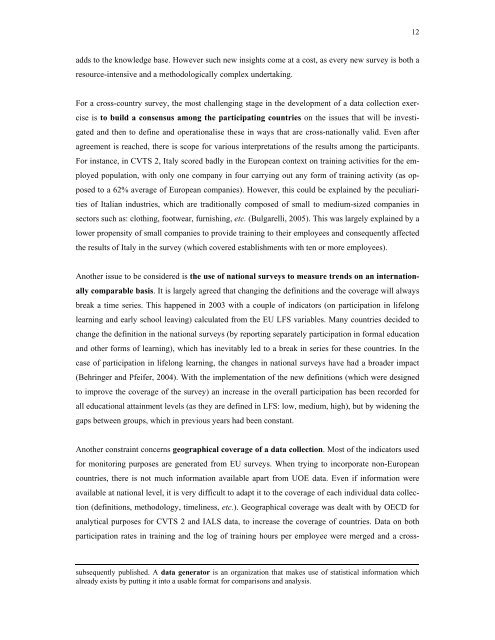measuring the outputs and outcomes of vocational training
measuring the outputs and outcomes of vocational training
measuring the outputs and outcomes of vocational training
Create successful ePaper yourself
Turn your PDF publications into a flip-book with our unique Google optimized e-Paper software.
12<br />
adds to <strong>the</strong> knowledge base. However such new insights come at a cost, as every new survey is both a<br />
resource-intensive <strong>and</strong> a methodologically complex undertaking.<br />
For a cross-country survey, <strong>the</strong> most challenging stage in <strong>the</strong> development <strong>of</strong> a data collection exercise<br />
is to build a consensus among <strong>the</strong> participating countries on <strong>the</strong> issues that will be investigated<br />
<strong>and</strong> <strong>the</strong>n to define <strong>and</strong> operationalise <strong>the</strong>se in ways that are cross-nationally valid. Even after<br />
agreement is reached, <strong>the</strong>re is scope for various interpretations <strong>of</strong> <strong>the</strong> results among <strong>the</strong> participants.<br />
For instance, in CVTS 2, Italy scored badly in <strong>the</strong> European context on <strong>training</strong> activities for <strong>the</strong> employed<br />
population, with only one company in four carrying out any form <strong>of</strong> <strong>training</strong> activity (as opposed<br />
to a 62% average <strong>of</strong> European companies). However, this could be explained by <strong>the</strong> peculiarities<br />
<strong>of</strong> Italian industries, which are traditionally composed <strong>of</strong> small to medium-sized companies in<br />
sectors such as: clothing, footwear, furnishing, etc. (Bulgarelli, 2005). This was largely explained by a<br />
lower propensity <strong>of</strong> small companies to provide <strong>training</strong> to <strong>the</strong>ir employees <strong>and</strong> consequently affected<br />
<strong>the</strong> results <strong>of</strong> Italy in <strong>the</strong> survey (which covered establishments with ten or more employees).<br />
Ano<strong>the</strong>r issue to be considered is <strong>the</strong> use <strong>of</strong> national surveys to measure trends on an internationally<br />
comparable basis. It is largely agreed that changing <strong>the</strong> definitions <strong>and</strong> <strong>the</strong> coverage will always<br />
break a time series. This happened in 2003 with a couple <strong>of</strong> indicators (on participation in lifelong<br />
learning <strong>and</strong> early school leaving) calculated from <strong>the</strong> EU LFS variables. Many countries decided to<br />
change <strong>the</strong> definition in <strong>the</strong> national surveys (by reporting separately participation in formal education<br />
<strong>and</strong> o<strong>the</strong>r forms <strong>of</strong> learning), which has inevitably led to a break in series for <strong>the</strong>se countries. In <strong>the</strong><br />
case <strong>of</strong> participation in lifelong learning, <strong>the</strong> changes in national surveys have had a broader impact<br />
(Behringer <strong>and</strong> Pfeifer, 2004). With <strong>the</strong> implementation <strong>of</strong> <strong>the</strong> new definitions (which were designed<br />
to improve <strong>the</strong> coverage <strong>of</strong> <strong>the</strong> survey) an increase in <strong>the</strong> overall participation has been recorded for<br />
all educational attainment levels (as <strong>the</strong>y are defined in LFS: low, medium, high), but by widening <strong>the</strong><br />
gaps between groups, which in previous years had been constant.<br />
Ano<strong>the</strong>r constraint concerns geographical coverage <strong>of</strong> a data collection. Most <strong>of</strong> <strong>the</strong> indicators used<br />
for monitoring purposes are generated from EU surveys. When trying to incorporate non-European<br />
countries, <strong>the</strong>re is not much information available apart from UOE data. Even if information were<br />
available at national level, it is very difficult to adapt it to <strong>the</strong> coverage <strong>of</strong> each individual data collection<br />
(definitions, methodology, timeliness, etc.). Geographical coverage was dealt with by OECD for<br />
analytical purposes for CVTS 2 <strong>and</strong> IALS data, to increase <strong>the</strong> coverage <strong>of</strong> countries. Data on both<br />
participation rates in <strong>training</strong> <strong>and</strong> <strong>the</strong> log <strong>of</strong> <strong>training</strong> hours per employee were merged <strong>and</strong> a crosssubsequently<br />
published. A data generator is an organization that makes use <strong>of</strong> statistical information which<br />
already exists by putting it into a usable format for comparisons <strong>and</strong> analysis.








